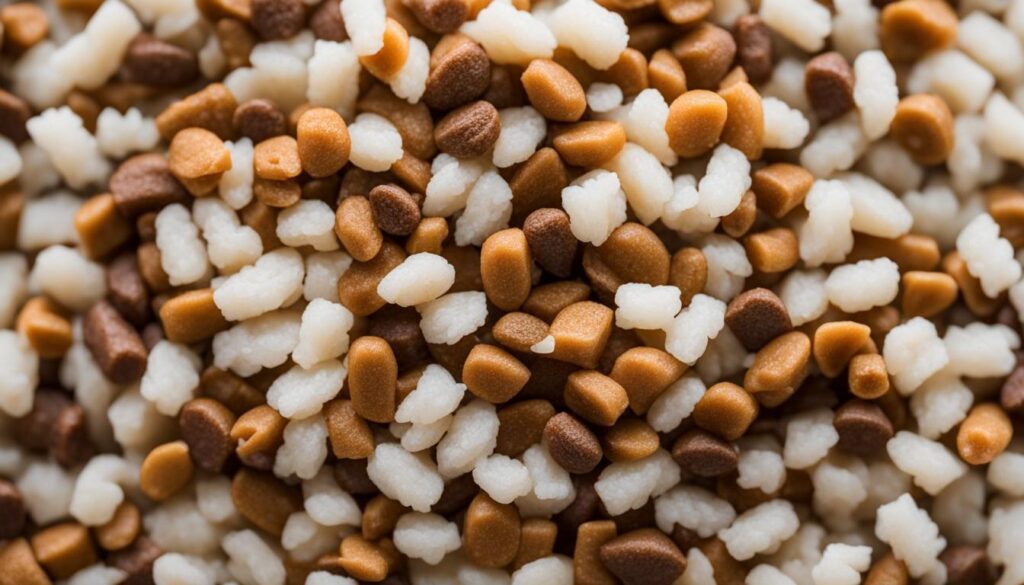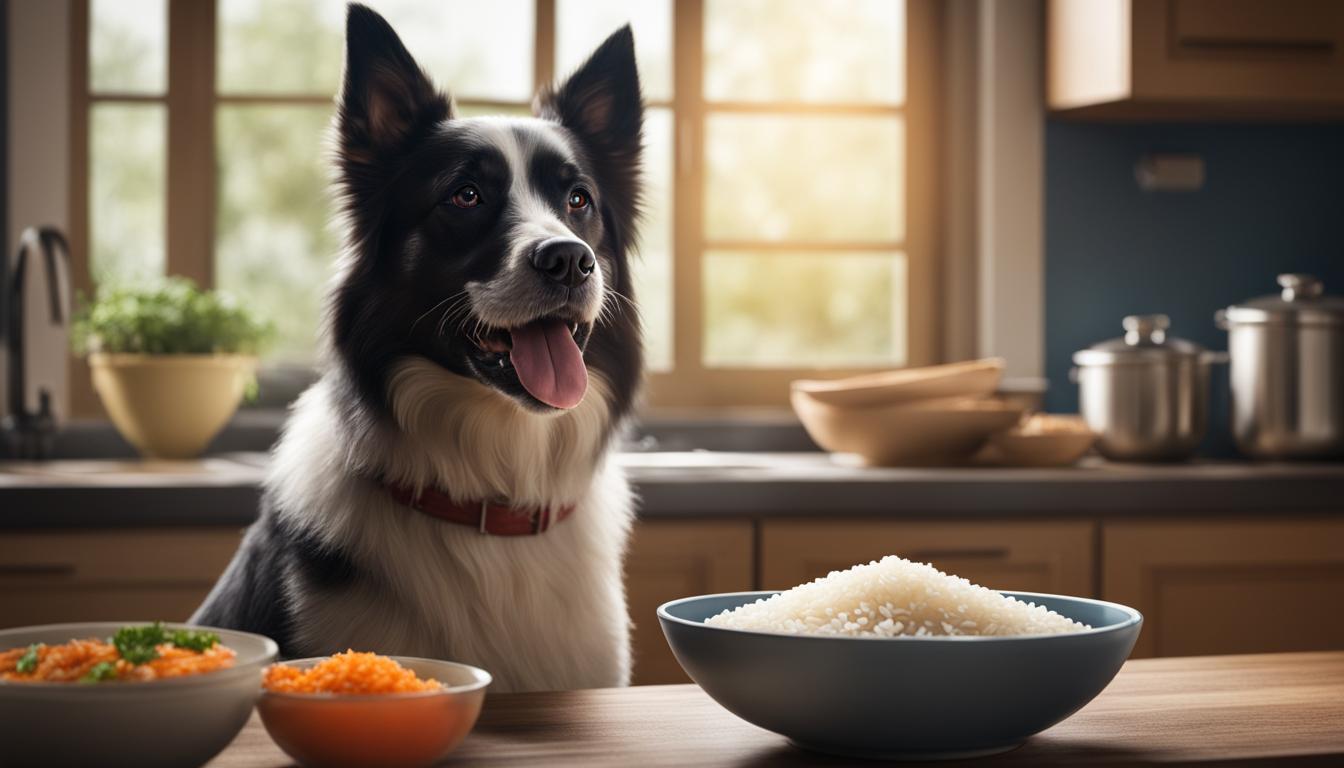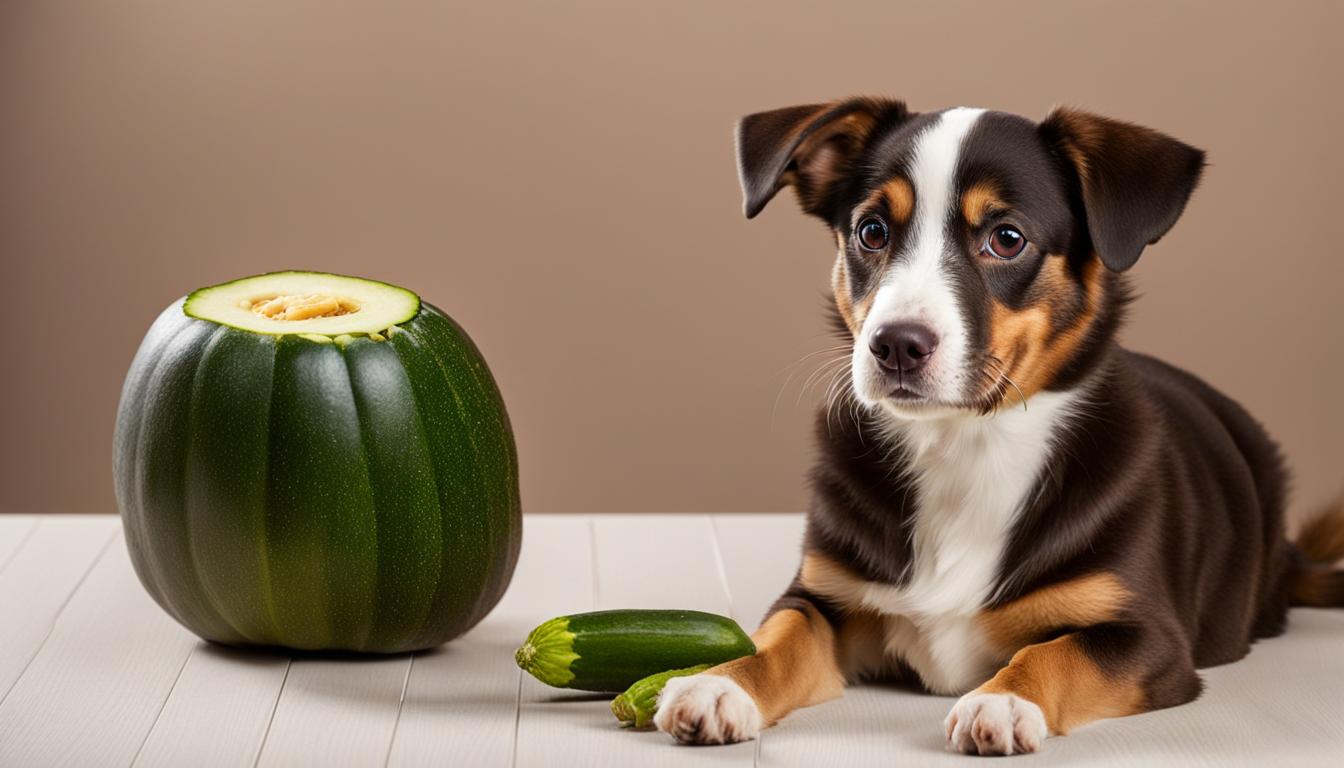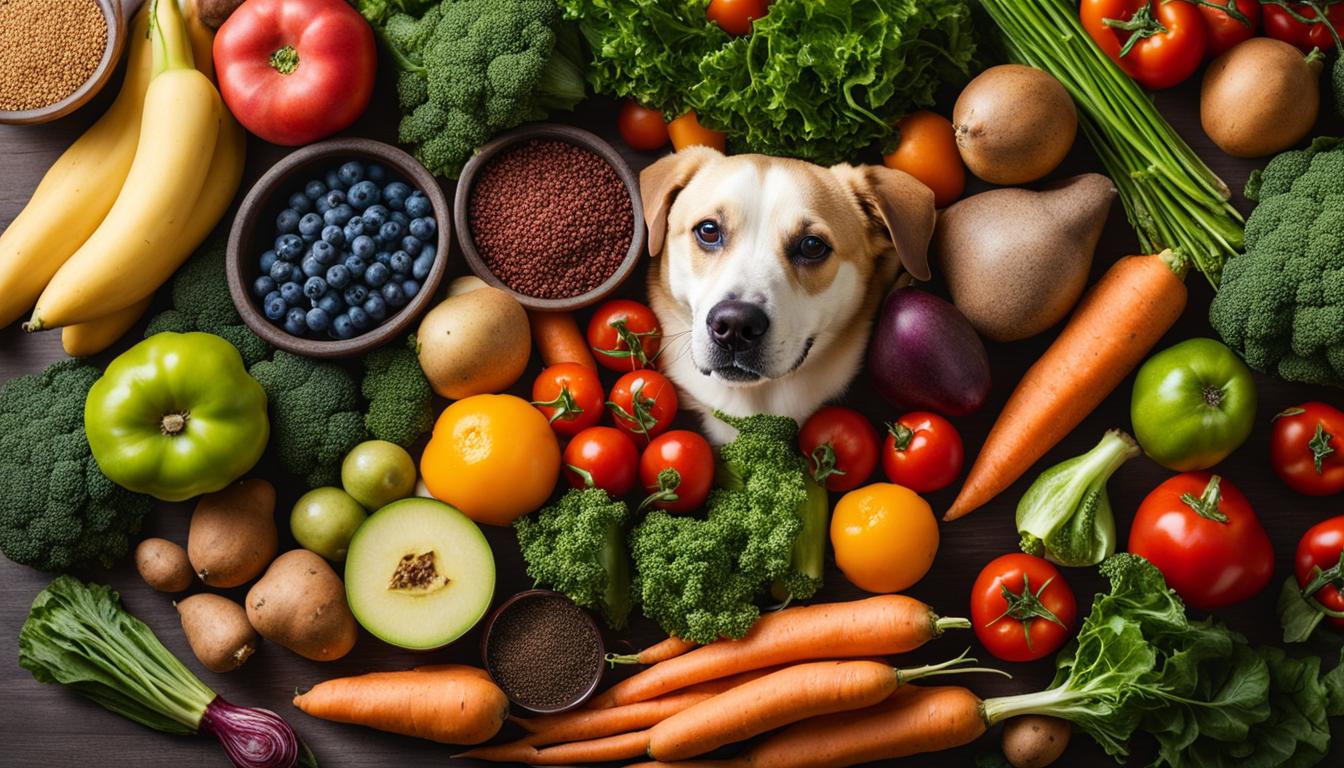Welcome to our guide on whether dogs can eat rice, and the nutritional value and digestibility of this popular staple. Rice is a carbohydrate that provides energy and can be easily digested by dogs. However, it’s important to understand that dogs don’t necessarily need carbohydrates in their diet as long as they’re getting sufficient amounts of meat, healthy fats, and nutrient-rich vegetables and fruits.
While rice isn’t high in fat, salt, or cholesterol, it is relatively low in vitamins, minerals, and phytonutrients. Brown rice is slightly more nutritious than white rice, as it contains fiber, manganese, iron, and B vitamins. However, the milling process removes some of these nutrients, and white rice is often enriched with synthetic nutrients.
It’s worth mentioning that rice can lower blood taurine levels in dogs, which is an essential amino acid for heart function. Overall, while dogs can digest rice, it may not be the most nutritious option for them.
Key Takeaways:
- Dogs can digest rice, but it’s not the most nutritious option for them.
- White rice is easily digestible, while brown rice contains more nutrients.
- Rice can lower blood taurine levels in dogs, which is essential for heart health.
- Consult with a veterinarian for specific dietary recommendations for your dog.
- A well-balanced diet that includes animal proteins, healthy fats, fruits, and vegetables is more beneficial for a dog’s overall health.
Is Rice Good for Dogs with Digestive Issues or Diarrhea?
When it comes to dogs with digestive issues or diarrhea, rice is often recommended as a bland and easily digestible food. It can help bind the stool and provide relief for gastrointestinal upsets. However, it’s important to note that there are better options available to address these issues. Fibrous foods like pumpkin or specialized diets formulated for digestive health may be more beneficial in providing the necessary nutrients and support for your dog’s digestive system.
Table: Comparison of Rice and Alternative Options for Dogs with Digestive Issues
| Food | Benefits | Considerations |
|---|---|---|
| Rice | – Easily digestible – Can help bind the stool |
– Low in essential nutrients – May not address the underlying cause of digestive issues |
| Pumpkin | – High in fiber, which can aid digestion – Contains vitamins and minerals |
– Should be fed in appropriate portions – Consult with a veterinarian for specific recommendations |
| Specialized Digestive Diets | – Designed to support digestive health – Contain easily digestible ingredients |
– May be more expensive than regular dog food – Consult with a veterinarian for appropriate brands |
It’s always important to consult with your veterinarian before making any changes to your dog’s diet, especially if they are experiencing digestive issues. Your vet can provide specific guidance and advice tailored to your dog’s individual needs. They can help you determine the best course of action and recommend the most suitable options to address your dog’s digestive concerns.
The Safety of Rice for Dogs
Rice is generally safe for dogs to eat when it is cooked, and it is a common ingredient in many commercial dog foods. It is non-toxic and contains various vitamins and minerals that can contribute to a dog’s overall health.
White rice is often recommended for dogs with gastrointestinal issues, as it is easily digestible and low in fiber. Brown rice, while also safe for dogs, may be harder to digest due to its higher fiber content.
It is important to feed rice to dogs in moderation, as it can raise blood sugar levels, especially in dogs with diabetes or obesity. Adding butter or other additives to rice should be avoided, as they can be harmful to dogs.
| Rice Type | Safety | Digestibility | Nutritional Value |
|---|---|---|---|
| White Rice | Safe for dogs | Easily digestible | Low in fiber |
| Brown Rice | Safe for dogs | Higher fiber content, may be harder to digest | Higher nutritional value than white rice |
Feeding Rice to Dogs: How to Safely Feed Your Dog Rice
Rice can be a part of your dog’s diet, but it’s important to feed it safely and in moderation. When preparing rice for your furry friend, it should be fully cooked and plain, without any seasonings or spices that can upset their stomach. Adding boiled boneless, skinless chicken or turkey in small amounts can enhance the flavor and provide additional protein. It’s essential to maintain the right rice-to-protein ratio, which should be 2:1 for dogs with ongoing digestive problems.

Feeding rice to your dog should be done under the guidance and recommendations of a veterinarian. They can provide specific advice based on your dog’s individual needs and dietary requirements. Consulting with a professional ensures that you are making the right choices for your dog’s health and well-being.
Remember, portion control is crucial when feeding rice to dogs. Treats and snacks, including rice, should only make up 10% of your dog’s diet. The remaining 90% should come from a well-balanced and nutritious dog food diet. The portion size of rice varies depending on your dog’s weight, ranging from 1-2 tablespoons for extra-small dogs to ½ cup for extra-large dogs. It’s always best to follow the portion guidelines provided by your veterinarian.
| Rice Portion Size | Dog Size |
|---|---|
| 1-2 tablespoons | Extra-small dogs |
| 1/4 cup | Small dogs |
| 1/2 cup | Medium dogs |
| 3/4 cup | Large dogs |
| 1 cup | Extra-large dogs |
Portion Control and Frequency of Rice for Dogs
When it comes to feeding rice to your furry friend, portion control and frequency are key factors to consider. While rice can be a part of a dog’s diet, it should be given in small amounts and in moderation. Remember, treats and snacks should only make up 10% of your dog’s overall diet, with the remaining 90% coming from a well-balanced dog food diet.
Rice can be considered as a treat for dogs and should only be given two to three times a week, unless otherwise advised by a veterinarian for medical reasons. The portion size of rice varies depending on your dog’s weight. For extra-small dogs, 1-2 tablespoons of rice is sufficient, while extra-large dogs can be given up to ½ cup of rice.
It’s important to note that the portion sizes mentioned here are general guidelines and may need to be adjusted based on your dog’s individual needs and dietary requirements. Consulting with a veterinarian is always recommended to ensure you are feeding rice and other foods in the appropriate portions for your dog’s overall health and well-being.
| Portion Size | Dog Size |
|---|---|
| 1-2 tablespoons | Extra-small dogs |
| ¼ – ⅓ cup | Small dogs |
| ⅓ – ½ cup | Medium dogs |
| ½ – ¾ cup | Large dogs |
| ¾ – 1 cup | Extra-large dogs |
Remember, it’s essential to maintain a balanced diet for your dog, and rice should only be a small part of their overall nutrition. Offering a variety of protein sources, healthy fats, fruits, and vegetables will ensure your furry friend receives the necessary nutrients for optimal health.
Considerations for Rice in Commercial Dog Foods
Rice is a commonly used ingredient in many commercial dog foods. While it is often included as a filler, there are several considerations to keep in mind when it comes to rice in dog food.
One important factor is the nutritional value of the rice. As mentioned earlier, rice is relatively low in vitamins, minerals, and phytonutrients compared to other ingredients. This means that if a dog’s diet primarily consists of commercial dog food that is high in rice, they may not be getting all the essential nutrients they need for optimal health.
Another consideration is the quality of the rice used in dog food. Most rice used in commercial dog foods is genetically modified (GMO), which can have negative effects on a dog’s gut health. Additionally, there is a risk of mycotoxin contamination in rice, which can be harmful to dogs. It is important to choose dog foods that prioritize the use of high-quality, non-GMO ingredients to ensure the best possible nutrition for your furry friend.
| Considerations for Rice in Commercial Dog Foods | Details |
|---|---|
| Nutritional Value | – Relatively low in vitamins, minerals, and phytonutrients – May not provide all essential nutrients |
| Quality | – Most rice used in commercial dog foods is genetically modified (GMO) – Risk of mycotoxin contamination |
It is also essential to consider the overall balance of a dog’s diet. While rice can provide carbohydrates and energy, it should not be the primary source of nutrition. Dogs require a well-rounded diet that includes high-quality animal proteins, healthy fats, and nutrient-rich fruits and vegetables to thrive.
Ultimately, when choosing commercial dog foods that contain rice, it is crucial to read the labels carefully and opt for products that prioritize nutritional value, quality ingredients, and a balanced diet. Consulting with a veterinarian can also provide valuable guidance and recommendations based on your dog’s specific needs and health concerns.

Conclusion
After exploring the topic of whether dogs can eat rice, it is clear that while rice is not harmful to dogs, it may not be the most nutritious option for them. While rice can provide dogs with easily digestible carbohydrates, it lacks the essential vitamins, minerals, and phytonutrients that they need for optimal health.
Rice can be used as a bland food for dogs with digestive issues or diarrhea, but there are better alternatives available that can provide more benefits, such as fibrous foods like pumpkin or specialized diets formulated for digestive health. In any case, it is always important to consult with a veterinarian for guidance and advice specific to your dog’s needs.
When introducing rice into your dog’s diet, it is crucial to do so in moderation. Rice should be fully cooked and plain, without any added seasonings or spices that can upset their stomach. Remember that treats and snacks should only make up a small portion of your dog’s diet, with the majority coming from a well-balanced dog food diet.
In conclusion, while dogs can eat rice, it should not be a staple in their diet. A balanced diet that includes animal proteins, healthy fats, fruits, and vegetables is the key to providing your dog with the necessary nutrients for their overall health and well-being.
FAQ
Can dogs eat rice?
Yes, dogs can eat rice. It is a carbohydrate that provides energy and can be easily digested by dogs. However, it is not the most nutritious option for them.
Is rice good for dogs with digestive issues or diarrhea?
Rice is commonly recommended as a bland food for dogs with digestive issues or diarrhea. It is easily digestible and can help bind the stool. However, there are better options available for addressing these issues.
Is rice safe for dogs?
Rice is generally safe for dogs to eat when it is cooked. It is non-toxic and contains various vitamins and minerals that can contribute to a dog’s overall health.
How should I feed rice to my dog?
When feeding rice to dogs, it should be fully cooked and plain. It is important to avoid adding seasonings or spices, as they can upset a dog’s stomach or be toxic. Adding small amounts of boiled boneless, skinless chicken or turkey can enhance the flavor and provide additional protein.
How much rice should I feed my dog?
Rice should be given to dogs in small portions and in moderation. The portion size varies depending on the dog’s weight, ranging from 1-2 tablespoons for extra-small dogs to ½ cup for extra-large dogs.
Are there any considerations for rice in commercial dog foods?
Rice is often used as a filler in processed dog foods. While it is safe, there are concerns regarding its nutritional value and safety. It is important to consider other ingredients like meat, poultry, fish, and eggs for a more nutritious option.
Can dogs eat rice? What is the conclusion?
Dogs can eat rice, but it is not the most nutritious option for them. Rice can be used as a bland food for dogs with digestive issues, but there are better alternatives available. A well-balanced diet that includes animal proteins, healthy fats, fruits, and vegetables is more beneficial for a dog’s overall health and well-being.





